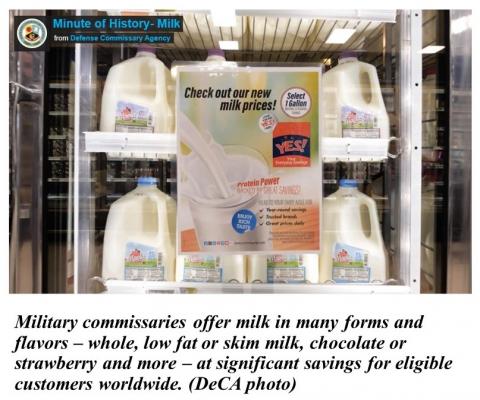WHOLE, LOW FAT OR SKIM: Milk has been a tasty staple of U.S. troops’ rations since the 1860s

FORT LEE, Va. – Milk is usually an easy purchase for commissary customers. However, throughout history the U.S. military has overcome many challenges to ensure its service members get access to this popular dairy product.
Today, military commissaries offer milk in many forms and flavors – whole, low fat or skim milk, chocolate or strawberry-flavored and more – at significant savings for eligible customers worldwide.
“You cannot imagine how hard it was for our service members throughout history to get milk with their meals in the field,” said Marine Sgt. Maj. Michael R. Saucedo, senior enlisted advisor to the Defense Commissary Agency director. “Fortunately, today our troops gain easy access to milk wherever they are.”
So, what’s the story about milk and the U.S. military? Well in 1857, Gail Borden & Company was founded in New York City. The following year the company started making condensed milk which involved adding sugar to raw milk and heating it and then rapidly cooling it. The process removed the water, leaving the milk evaporated. The finished product was then canned and had a long shelf life.
When the Civil War started in April 1861 the federal government became one of the Borden Company’s biggest customers. Borden sold the Union Army 500 pounds of condensed milk cans. The milk came in air tight, 10-ounce cans and contained 1,300 calories. Best of all, it could stay fresh for several months as long as the can wasn’t opened. The milk was also used in Union hospitals to treat soldiers with dysentery.
In 1862, Louis Pasteur, a French chemist and microbiologist, patented a process for improving milk safety by heating the milk to at least 161.6 degrees Fahrenheit and then cooling it before bottling. The process of pasteurization, named after its inventor, greatly improved the safety of milk. However, many customers complained pasteurized milk was tasteless.
Once the U.S. entered World War I, cases of evaporated milk were used to supply the need for whole milk for the U.S. armed forces and its allies, most coming from Nestle’s and Borden. Between 1914 and 1918, the annual production of evaporated milk more than doubled when small cans of evaporated milk were added to military rations throughout World War I.
By World War II, the Army Quartermaster Corps attempted to supply each soldier in the field with some form of 12 ounces of milk per man each day.
The troops received an A-ration, a combat ration (K-ration), and B-rations. Troops in training received no less than 75 pounds of evaporated milk each month. The procurement of fluid milk proved difficult to ship everywhere, especially long distances. Virtually all mess hall cooking in World War II was done with powdered or evaporated milk.
By the Korean War, cans of milk were replaced by small packets of dried milk which were included in B-rations. Dried milk was also usually used in recipes in mess halls.
Initially during the Vietnam War there were practically no dairy operations in Vietnam. Foremost Dairy of California opened a dairy in Saigon in December 1965 and Meadow Gold Dairy of Lexington, Kentucky, opened dairies in Cam Ranh Bay and Qui Nhon in 1967 and 1968. These dairies processed and packaged milk that was distributed to the troops. By 1969, over 75,000 cases of fresh milk were being distributed in Vietnam to the troops each month.
“The next time you drink milk with cookies or pour it over your cereal, think about how far we’ve come in pasteurization and packaging,” Saucedo said. “And remember you can save a lot of money on all of your milk purchases at your local commissary.”
-DeCA-
About DeCA: The Defense Commissary Agency operates a worldwide chain of commissaries providing groceries to military personnel, retirees and their families in a safe and secure shopping environment. Commissaries provide a military benefit, saving authorized patrons thousands of dollars annually on their purchases compared to similar products at commercial retailers. The discounted prices include a 5-percent surcharge, which covers the costs of building new commissaries and modernizing existing ones. A core military family support element, and a valued part of military pay and benefits, commissaries contribute to family readiness, enhance the quality of life for America’s military and their families, and help recruit and retain the best and brightest men and women to serve their country.
